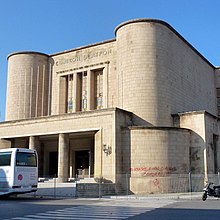Armando Bernabiti
Armando Bernabiti (Crevalcore, 4 March 1900 – Crevalcore, 4 March 1970) was an Italian architect.
Life and career
Born in Crevalcore, Bernabiti studied at the Academy of Fine Arts in Bologna and began working as an architect in Paris and Rome.[citation needed] He designed public and private buildings in a mostly Rationalist style, though with strong influence from local vernacular architecture.
Portolago
In 1923, Bernabiti was invited by Benito Mussolini along with Rodolfo Petracco to design the city of Portolago in Leros. The city's planning and architecture was inspired by modernism, Futurism, and classical geometry. Described as "the only truly rationalist town outside of Italy", their work on Portolago has been praised for its beauty, imagination and inclusivist nature.[1]
Rhodes

In 1927, he moved to the Dodecanese,[citation needed] which had been an Italian possession since 1912. Much of his work in Rhodes to helped to solidify Italian dominance on the island by transforming it into a destination for culture and tourism. His first work in Rhodes was the Archaeological Museum square in 1928. The design aimed to restore of the original character of the buildings with cues from Italian architecture to make it feel familiar to visitors.[2]

The Aquarium of Rhodes, an Art Deco design, was constructed between 1934 and 1935. When it first started operations in 1937, it was named the Reale Istituto di Ricerche Biologiche di Rodi (Royal Biological Research Institute of Rhodes). Research here included the hydrology, sponges, and fisheries of the Aegean.[3] In 1937, Bernabiti designed the National Theatre of Rhodes (previously Teatro Giacomo Puccini) in the International Style with glass brick masonry.[4] Using a modernist style, Bernabiti designed the Town Hall and the Casa del Fascio, the Cinema Theatre Roma, the Hotel Roma, a primary school and nursery, residential and commercial areas, and residences for military officers.[5] The ELLI building was designed and built from 1936 to 1938 to house bathing facilities, a refreshment room, and a diving boat in the sea.[6] It is designed in an eclectic style, blending the modernism with oriental details, to feature a prominent circular hall with arched window doors and numerous lozenge-form skylights.[6][7]
Other work
His other notable works include the Diagoras Stadium, St. Francis of Assisi Cathedral, and the Kallithea Thermal baths. In Kos, he designed both the Casa del Fascio and the Casa del Balilla.
References
- ^ Sakalis, Alex (31 January 2018). "The strange beauty of Greece's weirdest town". BBC Culture. Retrieved 10 October 2023.
- ^ Konstantinos, Karanasos (June 2, 2010). "The Politics for Urban Planning and Monument Managemetn in the City of Rhodes During the Italian Occupation 1923-1947: The Case of the Knights Hospital and the Surrounding Area". 8th International Symposium in the Conservation of Monuments in the Mediterranean Basin.
- ^ "Hydrobiological Station of Rhodes". rhodes-aquarium.hcmr.gr. Hellenic Centre for Marine Research. Retrieved November 29, 2015.
- ^ "Iconic National Theater of Rhodes to be restored and reopened | eKathimerini.com". www.ekathimerini.com. 2022-03-16. Retrieved 2023-12-31.
- ^ Orlandi, Luca (2010-01-01). "Italian Architects and Scholars in the Levant. The case of Rhodes and the Dodecanese Islands under the Italian Fascist Rule". Proceedings of the 1st International Meeting EAHN – Book of Abstracts / CD of Papers, (Jorge Correia editor).
- ^ a b Manola, Maria (February 2023). "Contribution of the Venetian Monuments of Rhodes to Cultural Tourism and the Local Development of the Island". Retrieved 31 December 2023.
- ^ "Ronda | Elli Rhodes". Retrieved 2023-12-31.